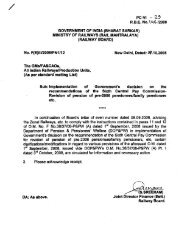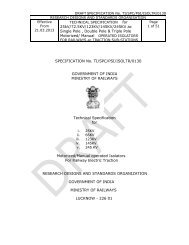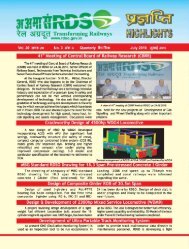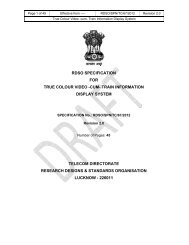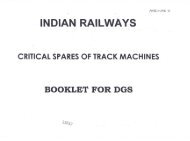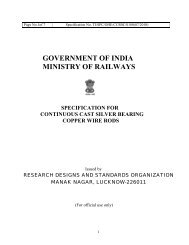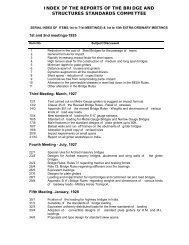ASSESSMENT OF RESIDUAL LIFE OF GIRDERS OF BRIDGE No
ASSESSMENT OF RESIDUAL LIFE OF GIRDERS OF BRIDGE No
ASSESSMENT OF RESIDUAL LIFE OF GIRDERS OF BRIDGE No
You also want an ePaper? Increase the reach of your titles
YUMPU automatically turns print PDFs into web optimized ePapers that Google loves.
Ni = Theoretical number of stress cycles corresponding to<br />
observed stress ranges from S-N curve.<br />
i = 1,2,3 …. Upto n stress ranges<br />
When the damage ( D) become equal to 1, the specimen fails and so the failure<br />
occurs when D= ∑ ni/Ni. = 1<br />
Many researchers have not been able to find good credence to this hypothesis.<br />
The main reason is that a stress cycles causes different extent of damage<br />
depending on its application on the material during its life. Research carried out<br />
by ORE, under question D-128, has suggested that under assumption of normal<br />
distribution of fatigue test data, the probability of failure by fatigue is considerably<br />
low when the life is evaluated at two Standard deviations below 50 % probability<br />
curve. To achieve this, the cumulative damage factor in the above equation is<br />
taken as 0.3, where N is taken from mean S-N curve. Therefore, in our study<br />
the criterion for fatigue failure is taken as D= ∑ ni / Ni = 0.3<br />
4.2.2 S.N. Curve: The relationship between constant amplitude stress range<br />
(Sre) applied to the specimen and number of cycles upto its failure (N) is called<br />
SN Curve. Generally it is plotted on log-log scale with number of cycles in<br />
millions on abscissa and stress range in N/mm 2 on ordinates. The slopping line<br />
represents the finite fatigue life of the material. Mathematically SN curves are<br />
defined in log-log form by the following equations:<br />
Log N = Log a –M.Log Sre<br />
Where, log a is the intercept on x-axis and M is the reciprocal of the slope of<br />
the finite life portion of the SN curve. In normal form N is represented by the<br />
following equation:<br />
N = a / (Sre) m<br />
4.2.3 Fatigue testing: Instead of using the S-N curve from the code for class<br />
‘D’, Twelve numbers of specimen ( Six numbers each from top and web plate ) taken for<br />
fatigue testing from the abandoned bridge <strong>No</strong> 73 girders for getting the actual fatigue<br />
behavior of the material. The result of the fatigue testing can be used for bridge <strong>No</strong>. 75 as<br />
the bridges are made up of similar material and are in operation on the similar times with<br />
similar traffic. The specimens were tested for fatigue life in RDSO laboratory. The<br />
specimen without holes were fabricated by welding end plates on either side of the<br />
specimen as shown in fig.1. and subjected to fatigue test as per program of loading as<br />
shown in table -2. The number of cycles at which the samples tested/failed is also shown<br />
in the table. Sample designated as W-1 and B-1 were tested up to 10 million<br />
cycles at the stress range 40 N/mm2 and did not fail even after completing 10<br />
million cycles. Other samples were tested up to 2 million cycles due to some<br />
higher load ranges and some of them failed before reaching 2 million cycles. The<br />
higher values of load ranges are selected, so that the values of stress ranges<br />
cover almost all the parts of the anticipated SN curve. The minimum load for<br />
fatigue testing is taken as 30 KN for all the samples. It has been observed that<br />
generally fatigue crack appears near the welding of end plates and propagates<br />
8


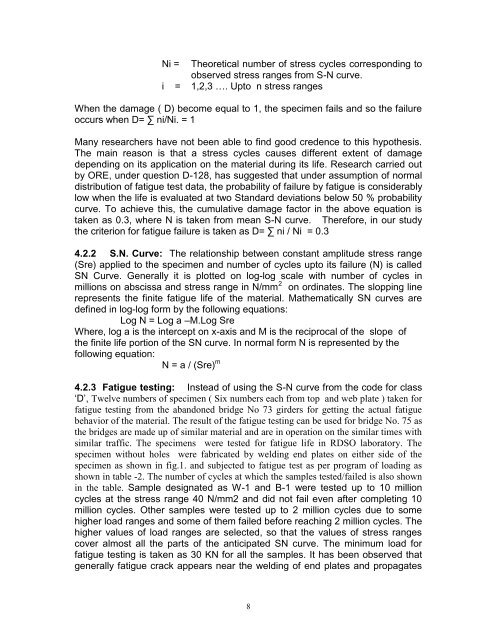
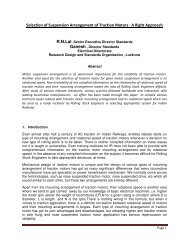

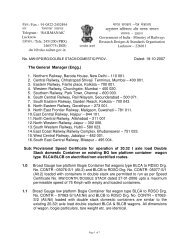
![Hkkjrljdkj] jsy ea= ky; vuql a/ kkuvfHkdYivkSj ekudlax Bu y ... - rdso](https://img.yumpu.com/21978459/1/184x260/hkkjrljdkj-jsy-ea-ky-vuql-a-kkuvfhkdyivksj-ekudlax-bu-y-rdso.jpg?quality=85)

